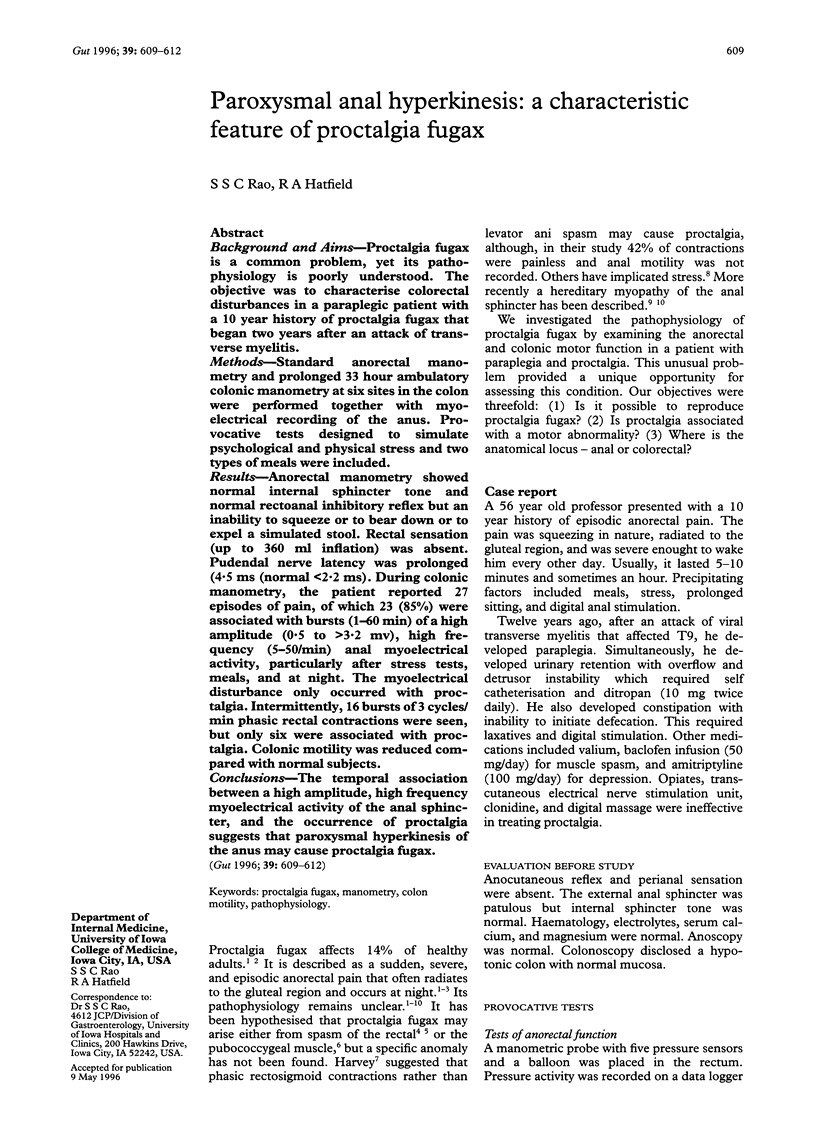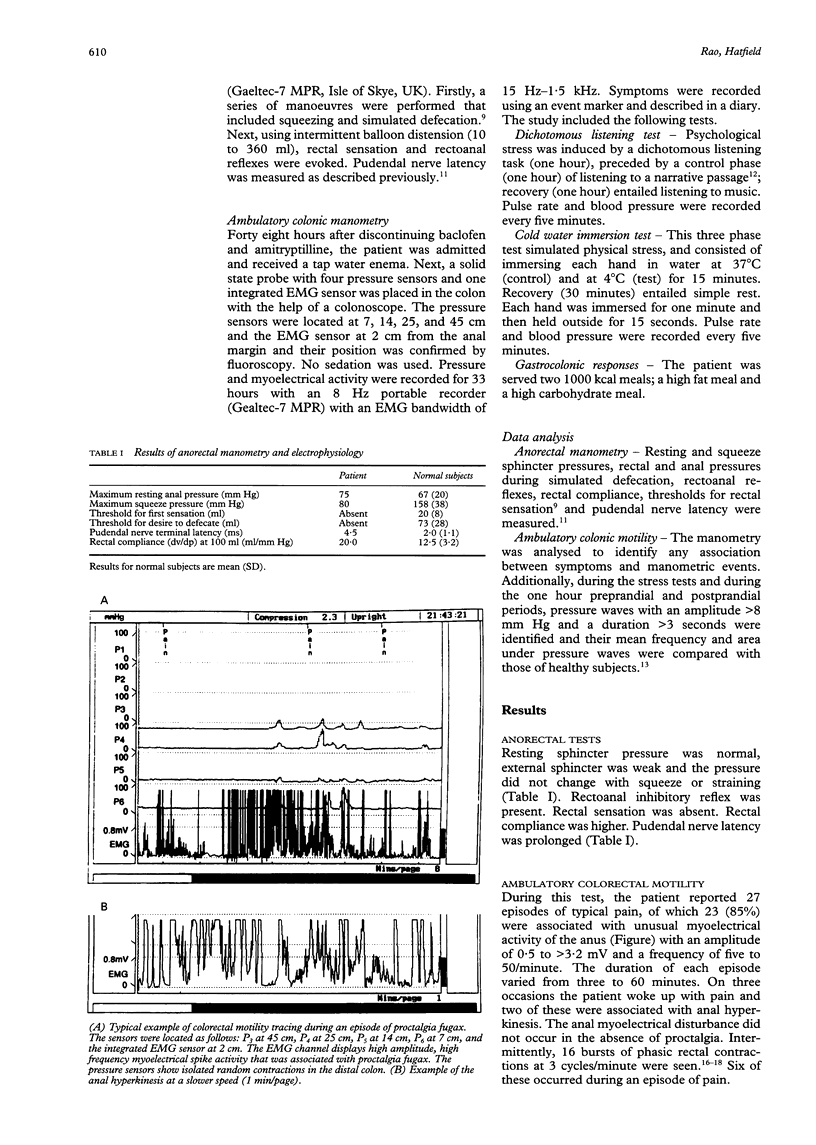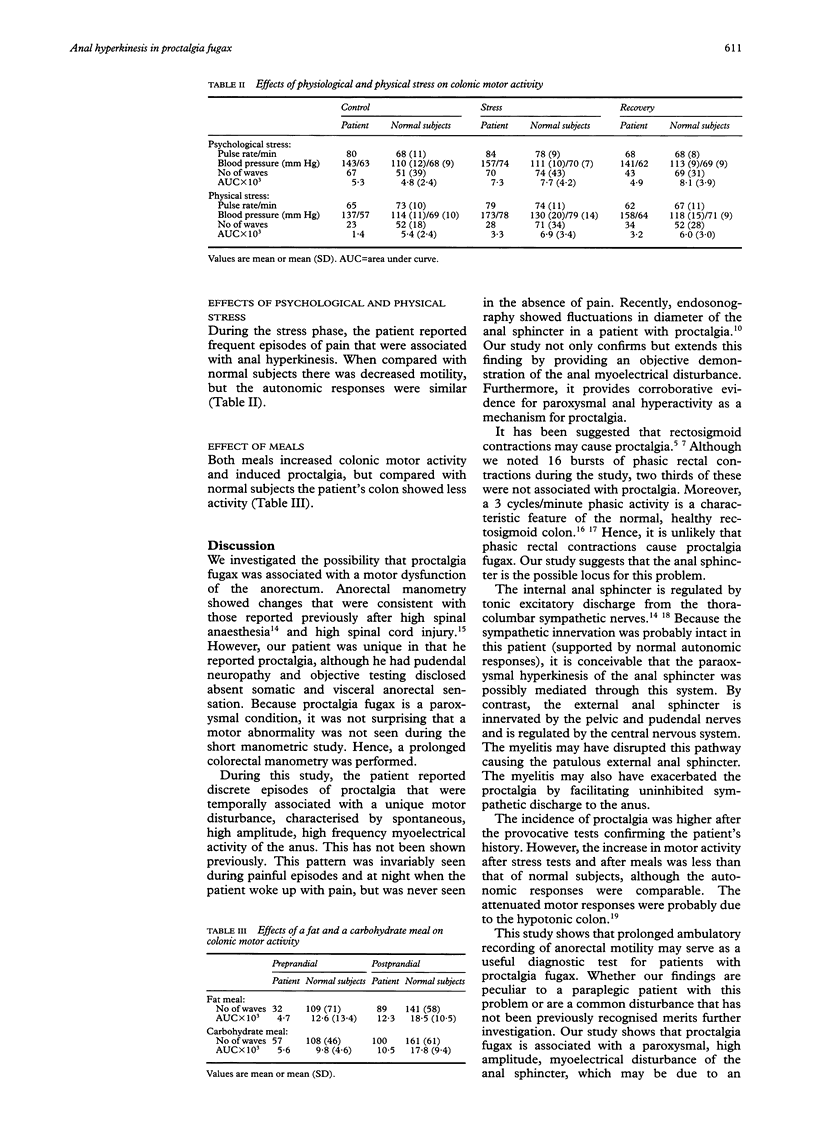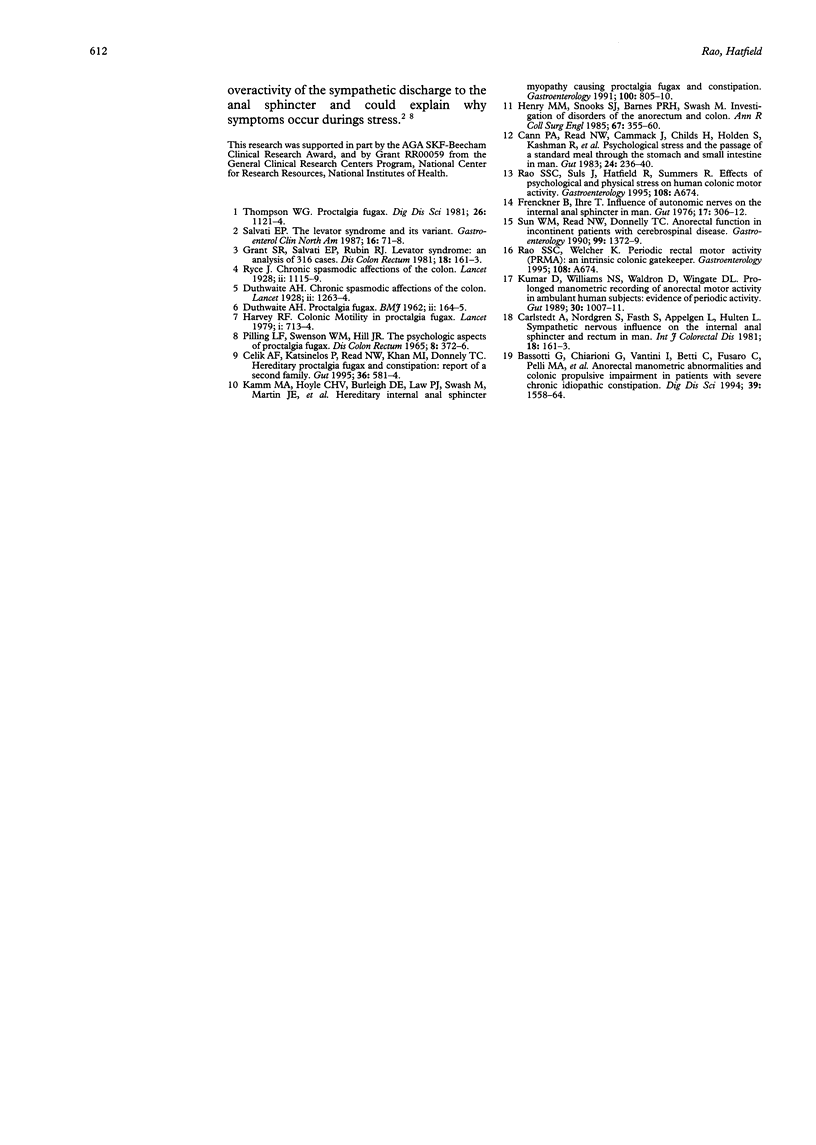Abstract
BACKGROUND AND AIMS: Proctalgia fugax is a common problem, yet its pathophysiology is poorly understood. The objective was to characterise colorectal disturbances in a paraplegic patient with a 10 year history of proctalgia fugax that began two years after an attack of transverse myelitis. METHODS: Standard anorectal manometry and prolonged 33 hour ambulatory colonic manometry at six sites in the colon were performed together with myoelectrical recording of the anus. Provocative tests designed to simulate psychological and physical stress and two types of meals were included. RESULTS: Anorectal manometry showed normal internal sphincter tone and normal rectoanal inhibitory reflex but an inability to squeeze or to bear down or to expel a simulated stool. Rectal sensation (up to 360 ml inflation) was absent. Pudendal nerve latency was prolonged (4.5 ms (normal < 2.2 ms). During colonic manometry, the patient reported 27 episodes of pain, of which 23 (85%) were associated with bursts (1-60 min) of a high amplitude (0.5 to > 3.2 mv), high frequency (5-50/min) anal myoelectrical activity, particularly after stress tests, meals, and at night. The myoelectrical disturbance only occurred with proctalgia. Intermittently, 16 bursts of 3 cycles/ min phasic rectal contractions were seen, but only six were associated with proctalgia. Colonic motility was reduced compared with normal subjects. CONCLUSIONS: The temporal association between a high amplitude, high frequency myoelectrical activity of the anal sphincter, and the occurrence of proctalgia suggests that paroxysmal hyperkinesis of the anus may cause proctalgia fugax.
Full text
PDF



Selected References
These references are in PubMed. This may not be the complete list of references from this article.
- Bassotti G., Chiarioni G., Vantini I., Betti C., Fusaro C., Pelli M. A., Morelli A. Anorectal manometric abnormalities and colonic propulsive impairment in patients with severe chronic idiopathic constipation. Dig Dis Sci. 1994 Jul;39(7):1558–1564. doi: 10.1007/BF02088064. [DOI] [PubMed] [Google Scholar]
- Cann P. A., Read N. W., Cammack J., Childs H., Holden S., Kashman R., Longmore J., Nix S., Simms N., Swallow K. Psychological stress and the passage of a standard meal through the stomach and small intestine in man. Gut. 1983 Mar;24(3):236–240. doi: 10.1136/gut.24.3.236. [DOI] [PMC free article] [PubMed] [Google Scholar]
- Celik A. F., Katsinelos P., Read N. W., Khan M. I., Donnelly T. C. Hereditary proctalgia fugax and constipation: report of a second family. Gut. 1995 Apr;36(4):581–584. doi: 10.1136/gut.36.4.581. [DOI] [PMC free article] [PubMed] [Google Scholar]
- DOUTHWAITE A. H. Proctalgia fugax. Br Med J. 1962 Jul 21;2(5298):164–165. doi: 10.1136/bmj.2.5298.164. [DOI] [PMC free article] [PubMed] [Google Scholar]
- Frenckner B., Ihre T. Influence of autonomic nerves on the internal and sphincter in man. Gut. 1976 Apr;17(4):306–312. doi: 10.1136/gut.17.4.306. [DOI] [PMC free article] [PubMed] [Google Scholar]
- Grant S. R., Salvati E. P., Rubin R. J. Levator syndrome: an analysis of 316 cases. Dis Colon Rectum. 1975 Mar;18(2):161–163. doi: 10.1007/BF02587168. [DOI] [PubMed] [Google Scholar]
- Harvey R. F. Colonic motility in proctalgia fugax. Lancet. 1979 Oct 6;2(8145):713–714. doi: 10.1016/s0140-6736(79)90642-1. [DOI] [PubMed] [Google Scholar]
- Henry M. M., Snooks S. J., Barnes P. R., Swash M. Investigation of disorders of the anorectum and colon. Ann R Coll Surg Engl. 1985 Nov;67(6):355–360. [PMC free article] [PubMed] [Google Scholar]
- Kamm M. A., Hoyle C. H., Burleigh D. E., Law P. J., Swash M., Martin J. E., Nicholls R. J., Northover J. M. Hereditary internal anal sphincter myopathy causing proctalgia fugax and constipation. A newly identified condition. Gastroenterology. 1991 Mar;100(3):805–810. doi: 10.1016/0016-5085(91)80030-d. [DOI] [PubMed] [Google Scholar]
- Kumar D., Williams N. S., Waldron D., Wingate D. L. Prolonged manometric recording of anorectal motor activity in ambulant human subjects: evidence of periodic activity. Gut. 1989 Jul;30(7):1007–1011. doi: 10.1136/gut.30.7.1007. [DOI] [PMC free article] [PubMed] [Google Scholar]
- Pilling L. F., Swenson W. M., Hill J. R. The psychologic aspects of proctalgia fugax. Dis Colon Rectum. 1965 Sep-Oct;8(5):372–376. doi: 10.1007/BF02627263. [DOI] [PubMed] [Google Scholar]
- Salvati E. P. The levator syndrome and its variant. Gastroenterol Clin North Am. 1987 Mar;16(1):71–78. [PubMed] [Google Scholar]
- Sun W. M., Read N. W., Donnelly T. C. Anorectal function in incontinent patients with cerebrospinal disease. Gastroenterology. 1990 Nov;99(5):1372–1379. doi: 10.1016/0016-5085(90)91164-2. [DOI] [PubMed] [Google Scholar]
- Thompson W. G. Proctalgia fugax. Dig Dis Sci. 1981 Dec;26(12):1121–1124. doi: 10.1007/BF01295979. [DOI] [PubMed] [Google Scholar]


